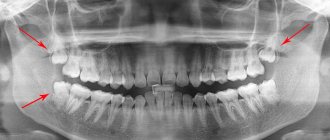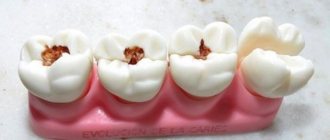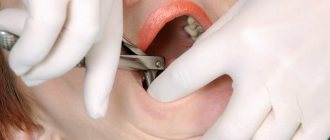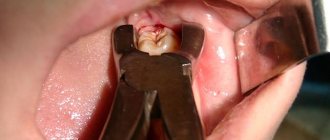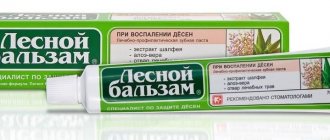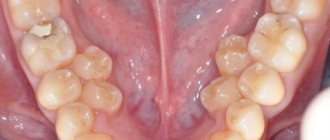Fluoridation of teeth
- an effective way to protect teeth from caries and strengthen the enamel structure with the help of certain fluoridated agents.
Fluorine is an important element for the body; the daily requirement for it is about 3 mg. It comes to us with water and some food products. If it is not enough, then the connection between calcium compounds concentrated in the enamel is destroyed, the surface becomes vulnerable, which leads to increased sensitivity and damage to the tooth tissue.
Indications and contraindications
Indications for fluoridation of teeth in dentistry:
- increased sensitivity of enamel, reaction to cold, hot, sour and sweet foods;
- susceptibility to caries disease, as a preventive measure for caries;
- after using braces and other orthopedic structures;
- lack of fluoride;
- after teeth enamel whitening.
Contraindications for the procedure when there is only harm from fluoridation:
- allergy to fluoride-containing drugs;
- excess fluoride in drinking water;
- fluorosis (change in tooth color due to oversaturation of fluoride from childhood).
Forewarned is forearmed!
Let's summarize: the harm to human health from using toothpaste with fluoride today cannot be considered a scientifically proven fact. Research in this direction is carried out regularly around the world, and its results can be found from open sources. It’s up to you to decide which product to choose for daily oral care for yourself and your loved ones. But when making such a serious choice, remember two important nuances.
- Fluoride is poison, and fluoride is medicine.
- Excess fluoride leads to fluorosis, while its deficiency makes the way for caries easier.
Types of fluoridation
There are two types of fluoridation: superficial and deep fluoridation of teeth.
Simple fluoridation of teeth
There are three simple methods used in dentistry:
- applying fluoride varnish to the tooth surface with a brush
. An invisible film is created. The procedure is repeated several times. The cost of fluoridation with varnish is affordable for everyone. Despite the fact that fluoride varnish therapy has been used for a long time, the remedy is still working and relevant. - electrophoresis
.
Better tissue permeability for fluoride molecules is achieved with small electrical pulses. At the first stage, electrodes impregnated with 10% calcium are attached to the teeth, at the second, this action occurs with sodium fluoride 2-4%. 10 procedures
are usually enough. - individual mouth guards
filled with a fluoride-containing preparation.
They are made quickly during a visit to the dentist, an impression is taken and the trays harden to the shape of the patient’s teeth. The material is elastic. The doctor fills the trays with a solution containing a photor. The patient puts them on for 5-10 minutes. 10 procedures
are recommended .
Deep fluoridation of enamel and dentin
A simple method is superficial; fluorine particles are large and cannot penetrate deeply. Deep fluoridation of teeth uses a solution of magnesium fluoride silicate whose molecular size is so small that the product acts deeper in the tissues, enriching them with a higher concentration of fluoride. Fluorine and calcium create strong crystalline bonds. At the end of the procedure, the teeth are coated with a “sealing” preparation. Fluoride compounds remain under it for a year and a half.
Conduct deep fluoridation up to twice a year
, not more often. The effect of this method compared to the simple one is 5 times higher.
Sodium Fluoride. What are the health hazards?
- Interesting
- Seal
On store shelves we usually see fluoridated toothpastes or mouth rinses. However, many people have recently been trying to avoid such hygiene products. Consumers are questioning the health benefits of sodium fluoride due to some information being revealed about the additive. This is despite the assurances of a number of dentists about the importance of fluoride for tooth enamel. Why is this happening? Have you ever wondered why fluoridated toothpastes have warnings on the label such as: “Children under 6 years of age are advised to use a pea-sized amount of toothpaste under adult supervision,” “Do not swallow,” “If fluoride is ingested, seek medical attention.” help”, etc. The reason toothpastes carry warning labels is to protect their manufacturers from lawsuits related to fluoride poisoning. Fluoride-free toothpastes usually do not have such warning labels because they do not have ingredients that can cause serious harm to the body. Today, dental pastes, tap water, and even milk are fluoridated. Fluoride can be contained in phosphorus fertilizers, therefore, black and green tea (which are grown using phosphorus fertilizers) may contain fluoride. And one more fact that is important to pay attention to. In a number of countries there is a ban on fluoridation of drinking water: Austria, Belgium, China, Czech Republic, Denmark, Finland, France, Germany, Hungary, India, Israel, Japan, Luxembourg, the Netherlands, Northern Ireland, Norway, Scotland, Sweden, Switzerland. And this is not at all accidental. When these countries learned about the “benefits” of fluorine, they immediately took the necessary decision at the legislative level - they banned its use. Since you now have a greater understanding of the reason for the warnings on fluoridated toothpaste labels, let's understand the differences between natural and synthetic fluoride so you know which fluoride to avoid.
Is it possible to do fluoridation at home?
The price of dental fluoridation in Moscow using the deep method will cost 2000-3000 rubles (all teeth), but you can do it yourself. Preparations for fluoridation at home are freely sold in pharmacies and specialized stores.
- Fluoride varnish
. Follow strictly the instructions, which indicate how and how many times to apply fluorine-containing varnish. - Therapeutic and prophylactic pastes and gels
. The composition should contain sodium fluoride, amino fluoride and other fluorides. We must remember that you cannot use such a paste for a long time so that there is no excess of fluoride in the body. Be sure to alternate with other types.
For effective fluoridation, it is better to consult with your dentist about choosing medications for home use. The result will be more lasting if you have professional teeth cleaning done beforehand to remove plaque and tartar.
How much fluoride does a person need and what foods contain it?
The daily dose of fluoride required for an adult is 0.03 mg/kg. During the period of formation and growth of the skeleton, the child’s body needs a larger amount - 0.15-0.1 mg/kg.
You can get this microelement from foods that are present in your daily diet:
- fish (the best source is mackerel, pollock, cod);
- all types of meat and offal;
- dairy products;
- raw nuts: walnuts, cashews, hazelnuts;
- fruits and vegetables (pumpkin, grapefruit, apple);
- mushrooms (ceps, chanterelles).
A balanced diet allows you to get fluoride from foods that are always in the refrigerator.
Differences from remineralization
Any method of dentin fluoridation is part of remineralization, artificial saturation of the enamel structure with micro- and macroelements by applying dental pastes, gels rich in calcium, fluorine, phosphorus, magnesium, zinc, etc. to the surface. The procedures have the same goal - prevention of caries, strengthening of enamel and replenishment microelements lost during demineralization. If pastes and gels for remineralizing dental tissue contain several components, then fluoridation agents contain fluoride ions.
Fluoridation increases the rate of remineralization several times. Since fluoride varnish seals dentinal tubules, the use of mineral complexes should be separate. First, remineralization, the final stage is fluoridation of teeth.
Pharmacological features
Most often in our lives we come across sodium monofluorophosphate in toothpaste. Qualified doctors can tell you what this compound is. It has long been discovered in medicine that fluoride ions can stabilize calcium, and this affects mineralization processes. Fluorapatite is formed, which is difficult to dissolve - due to this compound, hard tissues obtain their density. Fluoride ions are capable of initiating osteogenesis because they stimulate the activity of cells of the skeletal system.
The use of the composition allows to reduce bone resorption. An increase in resistance to the influence of osteoclasts is observed. Correct consumption of sodium monofluorophosphate helps increase bone mass. Fluoride ions penetrate into tooth enamel, it matures more efficiently and gains sufficient strength, which means the risk of caries is reduced. In addition, the bactericidal effect of the substance was revealed, especially pronounced in relation to the pathological microflora that causes caries. Due to this compound, bacteria less actively generate dangerous acids, including lactic acid.
Effect of fluoridation
Although tooth enamel contains less fluorine than calcium, it is simply necessary for the strength of the enamel. When fluoridating dentin, fluorine combines with tissue molecules and forms fluorapatite hydroxide, which is more resistant to acids. Namely, acids (acidic foods, waste products of bacteria in dental plaque) destroy tooth tissue, demineralization occurs, and micro- and macroelements that play an important role are washed out. Timely fluoridation of dentin prevents this process.
After the procedure:
- enamel becomes stronger;
- natural shine appears;
- susceptibility to caries is minimized;
- Calcium and phosphorus are better absorbed by dental tissue and retained there;
- enamel sensitivity decreases.
About caries and the fight against it with fluoride
There are three main factors that influence the development of dental caries: tissue susceptibility, the presence of an infectious strain of bacteria (Streptococcus mutans), excess sugar and other nutrients that stimulate bacterial growth. As pathogenic bacteria grow, an acidic byproduct is produced that can dissolve the minerals in the enamel. As a result, the tooth is destroyed.
Dentists recommend the use of fluoride solutions for treating the oral cavity and drinking fluoridated water. It is thanks to fluoride that there is an improvement in the condition of teeth and a sharp reduction in caries. Similar improvements have been recorded in different studies and in almost all age groups. However, tooth decay remains the most common infectious disease, and fluoride treatment remains an important tool in the fight against dental and oral diseases.
What happened before?
In earlier times, when sodium monofluorophosphate and its more advanced analogues were not yet known, a compound with tin was used to prepare toothpastes. This substance has a fairly high remineralizing ability, but there are also disadvantages. At first, areas of tissue poor in minerals lighten due to tin, but under the influence of fluorine, the opposite process of darkening occurs.
As further studies have proven, tin fluoride has a negative effect on the condition of the gums. The substance brings especially great harm to patients with periodontitis. Using a paste with stannous fluoride, you will soon notice a darkening of the enamel. The shade of the fillings changes, and the gums begin to ache. These days, this compound is found only in a limited range of toothpastes sold under the Colgate brand.
It is forbidden!
Sodium monofluorophosphate will become a source of harm if it is used by a child under six months of age. For systemic use, fluorides are prohibited if a person has kidney or liver diseases and dysfunction of these systems. You should not take fluoride in food if a peptic ulcer localized in the intestines or stomach has worsened. The period of childbearing and lactation also becomes a limitation. Fluoride should be used with caution in children under fourteen years of age.
Consequences of overdose
But the concentration of fluoride must be carefully monitored, since its overdose can lead to very adverse consequences:
- noticeable destruction of the intercellular substance of bone tissue—the bone matrix—begins;
- the functions of the thyroid and parathyroid glands are impaired;
- the functioning of the body's nervous system may be impaired;
- the body's metabolism changes;
- Spots may appear on the enamel layer of the tooth - the first sign of incipient fluorosis.
When is it used?
It is common to use fluoride, which produces sodium monofluorophosphate, as an element of a therapeutic course for osteoporosis. The substance is recommended both for people suffering from the steroid type and for those for whom the risks of such a pathology are assessed above average. Fluoride compounds can be taken by patients with primary osteoporosis of various natures, including the idiopathic form, in which the etiology of the case cannot be established. Fluoride compounds are prescribed to prevent caries in people of any age, as well as as part of a therapeutic course for local osteopathy. Fluoride supplements are recommended if the water a person drinks contains less than 0.6 mg/ml fluoride.

